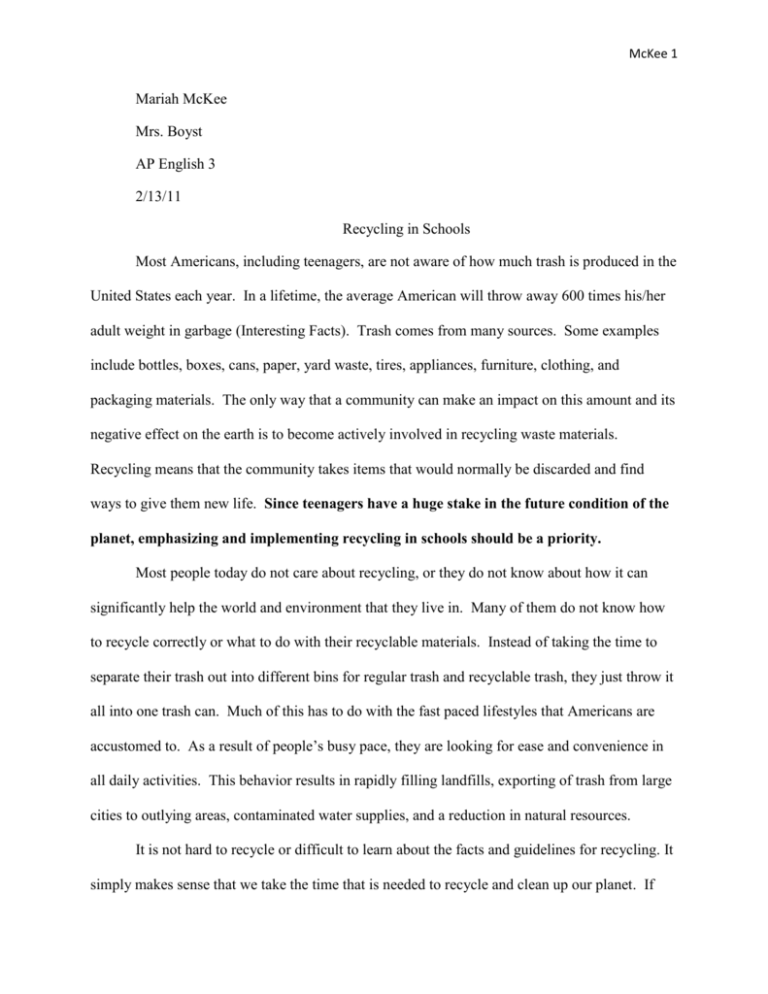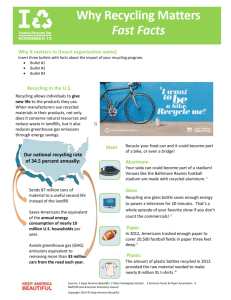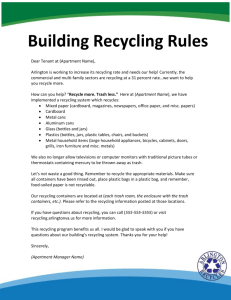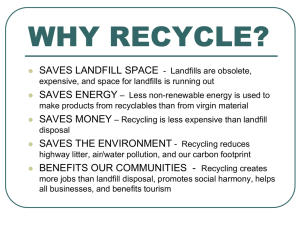Junior Paper
advertisement

McKee 1 Mariah McKee Mrs. Boyst AP English 3 2/13/11 Recycling in Schools Most Americans, including teenagers, are not aware of how much trash is produced in the United States each year. In a lifetime, the average American will throw away 600 times his/her adult weight in garbage (Interesting Facts). Trash comes from many sources. Some examples include bottles, boxes, cans, paper, yard waste, tires, appliances, furniture, clothing, and packaging materials. The only way that a community can make an impact on this amount and its negative effect on the earth is to become actively involved in recycling waste materials. Recycling means that the community takes items that would normally be discarded and find ways to give them new life. Since teenagers have a huge stake in the future condition of the planet, emphasizing and implementing recycling in schools should be a priority. Most people today do not care about recycling, or they do not know about how it can significantly help the world and environment that they live in. Many of them do not know how to recycle correctly or what to do with their recyclable materials. Instead of taking the time to separate their trash out into different bins for regular trash and recyclable trash, they just throw it all into one trash can. Much of this has to do with the fast paced lifestyles that Americans are accustomed to. As a result of people’s busy pace, they are looking for ease and convenience in all daily activities. This behavior results in rapidly filling landfills, exporting of trash from large cities to outlying areas, contaminated water supplies, and a reduction in natural resources. It is not hard to recycle or difficult to learn about the facts and guidelines for recycling. It simply makes sense that we take the time that is needed to recycle and clean up our planet. If McKee 2 people really did care about the outcome of recycling and knew how much better of a condition the world would be in, they would take the measures to recycle. This is an issue of educating everyone and especially the teenage generation. The impact of recycling is one that will reach into future generations. There are many things that can be done to minimize the problem of waste management. One thing that can be done is for schools to start a recycling program. Since recycling programs are not extremely hard to start or manage, and they are not too expensive; more schools in the community should invest in a recycling program. It is extremely important to keep the community and its surroundings clean. Especially since most landfills are starting to become full or over crowded. Studies show that “by 2010, almost all landfills in the UK will be full” (Recycling is). Each school should have a recycling program to help with trash and pollution problems. There are several different ways that recycling in schools can positively impact the environment and landfills. First and foremost, in a school’s recycling program, the school needs to assess their current facility, and make sure that everyone involved understands the end goal of what they want to accomplish (Bernard). Certain people should be appointed to be over the program to make sure that everything runs smoothly and is taken care of. There could be a special club or team that is made of students from the school so that they can help with the program and learn all about recycling and how it is done (Setting). Custodian workers should also be involved with the program from the beginning (School). It is especially important for the main people over the project to know where the local recycling businesses are so that they know where they need to take the school’s recyclables. Also, everyone in the school needs to be informed on how to recycle correctly and know what materials are recyclable. They all need to McKee 3 know where the recycling bins are located around the school so that they know where to put their trash. A person from the school could talk to someone at the local recycling plant to get them to pick up the recyclables weekly from the school or whenever the trash pickup day is for that area. If the school gets that set up, their recyclables will always get picked up. There are many rules and guidelines that must be done for recycling. One major thing is that all of the different types of materials have to be separated into different classes. Some of the different classes consist of paper, plastic, glass, metal, and wood. It is important to have the recyclables separated because they have to be separated in order to be taken to the recycling plants. With having everyone in the school involved with the project, it can have a larger impact and make a difference in the community (Bernard). Schools can have different labeled trashcans for the different recyclable items. To have a successful project, the school will have to follow the guidelines. In schools, batteries are used all of the time in calculators and in almost every type of technology device. Since, regular batteries are not able to be recycled because some of the materials that are used in them (Buff), the teachers could use rechargeable batteries. By using rechargeable batteries, it helps to keep toxic metals out of landfills and dumpsters. The toxic metals from the batteries leek out into the atmosphere and can cause damage (The Importance). By using rechargeable batteries in school, it helps to keep toxic batteries out of the landfills and there would also not be as big of a need to buy batteries. Schools can use rechargeable batteries to help the environment. At the end of each year, instead of all of the students throwing away their notebooks, they could do multiple things with them. Since most three ring binders are made out of cardboard and cardboard can be recycled, someone from the class could volunteer to take all the binders from McKee 4 the people who want to donate the binders and they could send them to a recycling plant for them to be recycled. Most students have multiple classes a year so they could have many notebooks a year. Instead of buying new notebooks every semester, they could reuse the ones they used for another class that they are not taking anymore. At the end of the school year, if the students do not want their binders anymore, the teacher could take them up if they are in good condition and give them to students the following year. That way the binders would still be recycled, just through other people. There is nothing wrong with binders that were used by someone before hand; they just may not look brand new. It is smart to use someone else’s used binder, because then that person would save money by not buying new ones, and all of those used binders would not go to different landfills to sit for years. Teachers can recycle the student’s binders each year to limit trash, and help the school’s recycling program. By recycling in the classroom, it helps to cut back some of the cost that the teacher spends on the students throughout the year (Durand, Maria F). Some teachers buy most of the books that are in their classrooms with their own money. Instead of getting new books all of the time, they could share books with different teachers in their school that teach the same grade. That way, the students have a wide variety of different books throughout the year and it does not cost the teachers anything. Mechanical pencils last longer than regular wood pencils in the classroom because when it runs out of led they can be refilled. When a regular pencil gets dull, it needs to be sharpened and it gets smaller and smaller. The teacher could keep a large amount of mechanical pencils and extra led in the classroom so when the student needs more led, they can just fill up their pencil. Paper is also a recyclable that is not always funded by the school. Most of the time paper is funded, but not every time. Paper is a major part of the classroom because it is used for everything. If more teachers and students started recycling paper, that McKee 5 would make a big difference. In lower grades such as Kindergarten, the classroom requires some toys. Instead of the teacher going out and buying new toys, they could ask parents of the students to bring in some toys that they might want to donate to the classroom (Durand, Maria F). They could also reuse toys and materials that they used in the past for many years. Teachers can use different ways to recycle in the classroom to help with recycling in the school. Promoting the idea of a recycling project in a school with school wide events gets the teachers, students, and parents all involved. “School wide events are very helpful with getting recycling programs known to the community” (Bernard). To have a successful recycling program, everyone in the school and community needs to know about it so that they can be a part of it. The more people that help, the cleaner the environment will be. Each school day, the students use multiple pages of paper for their work. If all the paper that is thrown away is recycled, it would save a lot more trees. One way that the teachers in the school can keep all of the thrown away paper separated for recycling is by keeping an extra bin in the classroom that the students can put all of their paper in that they are finished with. That would make a big difference, because most of the trash that is in the trashcans at school is paper. According to Lovetoknow, a main benefit of keeping less paper out of landfills is that decomposing paper releases methane gas into the air. Methane gas is harmful to the environment because once it gets into the air, people breathe it in and it can cause fatal outcomes (Cultrona). Most of the materials that are used in a lunchroom of a school are recyclable. A major material that can be recycled in a school is styrofoam cups. They are used every day in the lunch room by teachers and students. Studies have shown that “each year, Americans throw away 25 trillion styrofoam cups, and one cup will last in a landfill for 500 years” (Recycling Facts). To help minimize this problem someone over the recycling program in the school could put one or McKee 6 two special trashcans in the lunchroom specifically for those styrofoam cups and possibly the styrofoam plates. “Americans toss out enough paper and plastic cups, forks and spoons every year to circle around the equator 300 times” (Trash). School wide events are great to get the word out, but there also needs to be some sort of funding for the program. Schools to recycle many of those lunchroom trash items in their recycling project. Funding plays a major role in recycling projects. Without the funding, there would be no program at all. To get funding for the programs, the school could form partnerships with nonprofit organizations and community service clubs (Bernard). It is important to have a separate banking account at the school to put all of the funding into for the program. Recycling programs are not extremely expensive but someone should still keep track of the money for it. One way that the school can earn money for their recycling fund would be to have fundraisers; it would also get more people involved from the community. Also, the teachers in the classroom can remind the students in the room to put their trash in the correct recycling bin so that they do not forget. Many students do not think about recycling or care about it. If they actually put all of their recyclable trash into recycle bins, that would help the environment a great amount. Once the school receives funding for their program, they should decide the type of program that would be best for their school. Selecting the right type of recycling program for each school is a crucial step in the recycling process. The school would want to choose a program that is in their budget and one that the faculty and students agree on. Many people do not fully understand all of the facts and details about recycling and how it works. To be able to pick the right kind of program, the faculty and students of the school would need to know some of the basics before deciding on the program. The school could take about 30 to 45 minutes out of one day to address the recycling McKee 7 program and discuss what all needs to be done for the program to work and be successful. There needs to be a set number of drop-off places and special bins around the school for the recyclables. To determine how many recycling drop-off places are needed around the school would be compared to how many students there are in the school; also it could be compared to how small or big the school is. After selecting the type of program, the school needs to identify which recyclables they will use in the project. Determining which recyclables that the school is going to use in their waste stream is extremely important. The school can use one recyclable or multiple. The number that they use will more than likely relate back to their funding and budget (Guidelines to Starting). It is important to know which recyclables are going to be used in the program because it would need to be addressed to the school community so that everyone knows what to recycle. There would need to be the proper amount of bins and trashcans that are labeled with the correct recyclable on the front. If the school makes a special club for the project, the students from that club would mark which type of materials would go in each of the bins. The bins would need to be easily identifiable from the regular trash cans. They could be different colors or they could say what goes in them on the outside. The trash cans or bins should have a lid or a cut out opening on the top to cut back on contamination around the bins (School). The school can have however many recyclables that they would like to have in their project. Having only one or two recyclables is better than having none. By not recycling, there can be many harmful outcomes because of it. “Harmful chemicals and greenhouse gasses are released from rubbish in landfills” (Recycling is Important). These harmful chemicals are not good for the environment or people and animals that live around them. The harmful chemicals and gasses can get into the homes and bodies of McKee 8 people by them breathing in the harmful substances. They seep from the landfills into streams and into the air (Buff). These harmful chemicals that run into streams and bodies of water can cause harm to the fish and other things that live in the water. Most landfills are located around streams and bodies of water so that is very likely to happen (Recycling Statistics). There are only nine cities in Cleveland County that have landfills, Eric Buff stated in the interview (Buff, Eric). There are some things that can be done to reduce some of the harmful chemicals. By recycling paper, fewer harmful chemicals are released into the air. “Recycled paper does not need re-bleaching, meaning that fewer harmful chemicals are released into the environment” (How Does). Tons of trash goes to different landfills every day from different places. Factories, large organizations, schools, and homes are just a couple main places that most trash comes from (Recycling Statistics). Sooner or later, all trash is taken to a landfill somewhere in the world. Some parts of the world burn their trash in an incinerator (Buff, Eric). There is only a certain amount of time that those landfills will last, and a certain amount of trash that they will hold. T The garbage in the landfills is tightly packed by machines and covered by other trash. There is little oxygen and moisture inside of landfills (Freudenrich). This prevents the trash from decomposing quickly. “The average time taken by plastic bottles to decompose in a landfill is close to 700 years” (Recycling Statistics). Plastic also takes up a lot of space in landfills. One of the fastest decomposing recyclable is Aluminum (Recycling Statistics). The Aluminum cans can be used after they are recycled. According to Recycling Statistics, they are usually recycled in about 60 days and back on the grocery store shelves for sale. Every day an average American produces around 4.6 pounds of trash (Kaufman). Landfills are cells in the ground that hold trash, and they can usually last from eight to nine years (Buff). Landfills take years to be built and they are extremely costly. The recycled trash is taken from the recycled centers to different landfills McKee 9 that are located throughout the county. By not recycling, there has been an increase in pollution. Recycling makes a major difference in the community and it helps to keep our landfills clean. Each school should have a recycling program that will help to minimize and reduce trash problems in the community. There is an average of 320 tons of trash brought into landfills each day in the county (Buff). By starting a recycling program in each school throughout the community, is just a start to what all can be done to help keep the environment clean, and to also keep the landfills less crowded. If people do not start to take actions to protect their community and environment soon by recycling, there is no telling how things will end up. If just a couple of schools in the community started an effective recycling program, the environment would be in a far better condition than it is now. McKee 10 Interview Questions With: Eric Buff Works at a recycling plant in Shelby 1. What happens to recyclables? - We sell recyclables to other counties to get money and to clear some of our landfills. 2. How many tons of trash is in landfills? - 320 tons a day. It goes into cells in the ground and the cells can last from 8-9 years. 3. Where do you take recycled trash? - 9 cities in the county have landfills that we use. 4. What are some guidelines for recycling? - It has to be separated into different classes. 5. What materials are recycled? - Metal, Aluminum, Oil, Paper, Plastic, and Wood. 6. In what ways does recycling make a difference? - Keeps waste out of landfills and environment clean. 7. Is recycling paper polluting? - No, because it saves trees from being cut down. 8. Why are alkaline batteries not always recyclable? - Because of the different materials that go in them that cannot be recycled. 9. Why can’t painted wood be recycled? - Because some paint is lead based and it cannot be recycled because of the process wood goes through. McKee 11 10. Why is glass not recycled? - Glass can be recycled. McKee 12 Works Cited Bernard, Sara. How to Reduce Your School’s Eco-Footprint. Oct. 2007. Web. 1 Jan. n.d. <http://www.edutopia.org/how-to-reduce-school-carbon-footprint>. Buff, Eric. Personal interview. 26 Sept. 2010. Cultrona, R.L.. The Effects of Breathing Methane Gas. N.p., n.d. Web. 27 Jan. 2010. <http://www.ehow.com/list_5919157_effects-breathing-methane-gas.html>. Durand, Maria F. "Teachers Spend Own Money for Supplies." ABC News. 31 Aug. Web. 1 Jan. <http://abcnews.go.com/US/story?id=95922&page=1>. Freudenrich, Craig. "How Landfills Work." HowStuffWorks. N.p., n.d. Web. 1 Jan. 2010. <http://science.howstuffworks.com/environmental/green-science/landfill7.htm>. Guidelines to Starting a School Recycling Program. North Carolina Department of Environment and Natural Resources, n.d. Web.1 Jan. n.d. http://www.recycleguys.org/guidelines.asp>. Interesting Facts About Recycling. N.P., n.d. Web. 1 Jan 2001. <http://www.orberlin.edu/recycle/facts.html>. How Does Recycling Paper Help Landfills." Lovetoknow. San Mateo County RecycleWorks, n.d. Web. 18 Apr. 2008. <http://greenliving.lovetoknow.com/How_Does_Recycling_Paper_Help_Landfills>. Kaufman, Leslie. “Nudging Recycling From Less Waste to None.” The New York Times. 20 Oct.2009: n. page. Web, 19 Oct. 2009. <http://www.nytimes.com/2009/10/20/science/earth/20trash.html?_r=1&ref=recycling_of_wa ste_materials>. Recycling Facts. St. Charles County Division of Environmental Services, n.d. Web. 1 Jan. n.d. http://www.scchealth.org/docs/es/docs/recycle/recycling_facts.html>. Recycling Facts: Reuse. N.d., Web.1 Jan.2010. McKee 13 <http://www.cityofinglewood.org/Pdfs/pw/Recycling_Facts.pdf>. Recycling is Important. N.p., n.d. Web 22 Mar. 2003. http://www.recyclingguide.org.uk/importance.html>. A Recycling Revolution. The National Recycling Coalition, n.d. Web. 1 Jan. 2010. <http://www.recycling-revolution.com/recycling-facts.html>. Recycling Statistics and Facts. n.d. Web. 1 Jan. 2009. <http://www.all-recycling-facts.com/recycling-statistics.html>. School Recycling . N.p., n.d. Web. 1 Jan. http://www.dep.state.pa.us/dep/deputate/airwaste/wm/recycle/school/School_Guide.htm. "Setting Up a School Recycling and Waste Reduction Program." San Mateo County RecycleWorks, 2010. Web. 1 Jan. 2010. <http://www.recycleworks.org/schools/schoolpgm.html>. The Importance of Recycling. N.p., n.d. Web. 1 Jan. 2004. http://www.nsf.org/consumer/recycling/>. Trash Trivia. N.p., n.d. Web. 1 Jan. <http://www.co.cass.in.us/ccswd/trivia.htm>.
![School [recycling, compost, or waste reduction] case study](http://s3.studylib.net/store/data/005898792_1-08f8f34cac7a57869e865e0c3646f10a-300x300.png)





